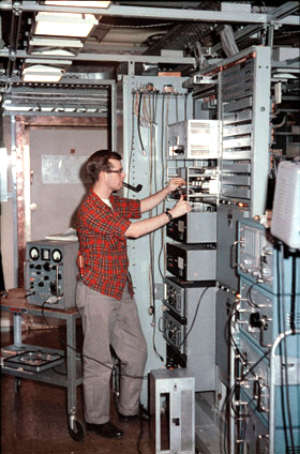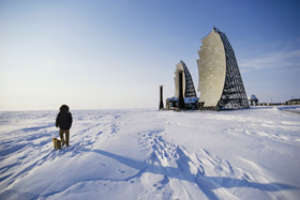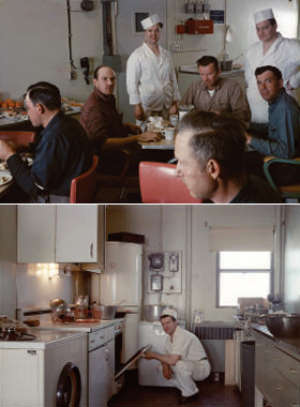March 18, 2007
Distant Early Warning
Nice article at American Heritage Magazine about the 1950's through 1980's radar stations in the Canadian Arctic:The Dew LineA bit about life at the stations:
It was North America’s first defense against a Soviet attack, and life on it was the Cold War at its coldest.
In the early hours of April 17, 1952, World War III nearly began—although not many people realized it at the time.
The previous afternoon an intelligence source had reported unusual levels of activity at Soviet air bases. Shortly after midnight U.S. Air Defense Command headquarters, in Colorado Springs, got word from Alaska that vapor trails from “bogeys” (unknown aircraft) had been sighted high over the Bering Sea, coming from the direction of the Soviet Union. As shaken generals fretted over the report, another message arrived: Five more bogeys had been sighted off the coast of Maine. It looked as if this might be the real thing—an atomic sneak attack. Commanders ordered a full-scale alert. Fighters were scrambled and Air Force bombers prepared for a retaliatory strike.
And then nothing happened. The vapor trails over Alaska disappeared, along with the supposed enemy bombers. The unknowns over Maine were identified as off-course civilian airliners. Faster than it had begun, the threat vanished.
Although the people of North America slept undisturbed through the incident, it was ice water in the face for the military. It was bad enough that the U.S. defense network had been brought to the brink of war by such flimsy evidence. Much worse, though, was that it had taken 90 minutes for the first report of enemy planes to make its way up the chain of command to those in charge, and even longer to figure out what was actually going on. The mechanisms in place to spot, report, and confirm sightings of unknown aircraft were more suited to the Battle of Britain than the jet age.
How could America tell the difference between a real enemy attack and an apparent one? In the aftermath of the 1952 incident the defense establishment studied this question intently, and a big part of the answer turned out to be the Distant Early Warning Line—the DEW Line, for short—a string of radar stations along the very edge of civilization in one of the most desolate, hostile, cold, and empty places on earth.
Upon the handover, the military enlisted another AT&T subsidiary, Federal Electric, to operate and maintain the DEW Line. Although it was under military control, the line was staffed and run chiefly by civilians, with Air Force officers at the main stations. What could possibly have persuaded someone to spend a year or more sitting in prefabricated housing, staring at a radarscope, in the middle of a frozen wilderness?Here are some photos from the article:
“Money,” says Lynden (“Bucky”) Harris, who signed up for several tours on the DEW Line, working various jobs, including personnel, transportation, and logistics, and eventually managing the entire line. “The money was very attractive.” Workers signed up with Federal Electric for 18 months (with a two-week leave at the halfway point) at $1,000 per month plus a $1,500 bonus at the end of the stint. In the late 1950s those wages rivaled the earnings of doctorate-level engineers and professional baseball players. Better yet, the pay increased markedly with additional tours.
Applicants had to have appropriate experience and expertise, and they had to pass a battery of interviews and tests. “I went for the interview in Los Angeles,” says Mike Shaw, a DEW Line veteran from 1962 to 1964 and 1968 to 1973. “They gave you about 50 tests. We joked for years after that that they had to make sure you were crazy.” After acceptance, all personnel received specialized training. Technician/operators, who would form the backbone of the line, were sent to radar school in Streator, Illinois. After six to eight weeks they graduated to their new duties as “radicians,” a contraction of radar operator and technician. Radicians were also trained in first aid, weather observation, and cryptography. Other DEW Liners worked as cooks, mechanics, administrators, and pilots, among other occupations.



Comments
Post a comment